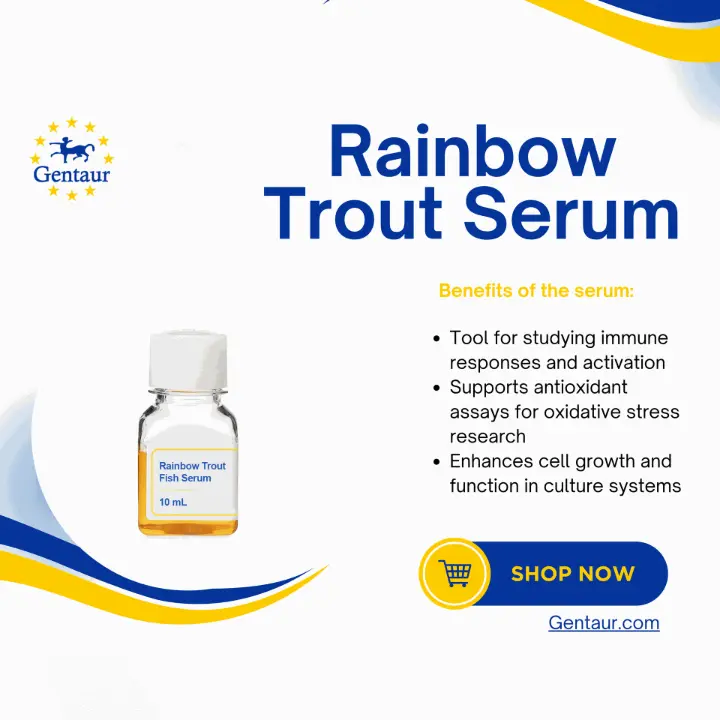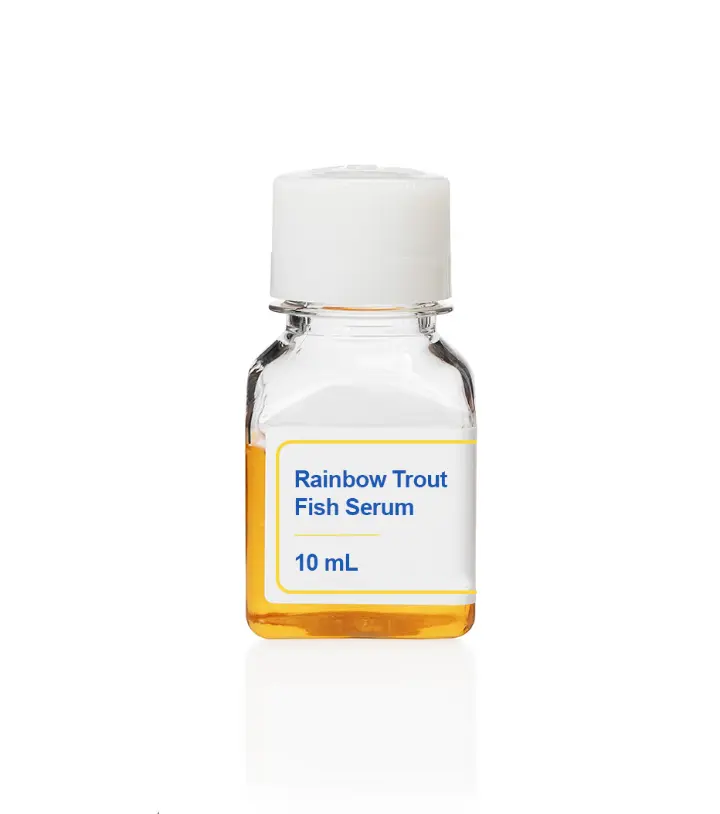Chapter 1: Understanding Rainbow Trout Fish Serum – A Natural Resource Reimagined
In the vast universe of cell culture, media supplements play a critical role in modulating cell viability, proliferation, differentiation, and response to external stimuli. Traditionally, Fetal Bovine Serum (FBS) has dominated the field as a gold-standard supplement. However, as research models expand beyond mammals—particularly into aquatic and cold-blooded species—the need for species-appropriate, ecologically relevant alternatives becomes increasingly evident. This is where Rainbow Trout Fish Serum (RTFS) steps in as a powerful niche product.
What is Rainbow Trout Fish Serum?
Rainbow Trout Fish Serum is a blood-derived fluid collected from Oncorhynchus mykiss, a cold-water teleost fish widely used in aquaculture and environmental studies. The serum is obtained post-coagulation and processed under sterile conditions. It is rich in:
- Fish-specific growth factors
- Unique protein profiles
- Lipid carriers and transport proteins
- Cold-active enzymes and immune components
This makes RTFS fundamentally different from mammalian sera—not inferior, but evolutionarily optimized for fish cells and potentially advantageous for certain non-mammalian cells.
Why Use Fish Serum?
The evolutionary divergence between fish and mammals leads to significant biochemical and physiological differences. Using mammalian-derived supplements in fish cell cultures can create suboptimal environments, leading to low cell adhesion, poor proliferation, and altered metabolic activity. Rainbow Trout Fish Serum, on the other hand, offers a more physiologically relevant milieu, supporting the native behavior of piscine cells.
Chapter 2: Comparative Biochemistry – What Sets RTFS Apart?
To appreciate the value of Rainbow Trout Fish Serum, it's important to understand its biochemical uniqueness in comparison to more traditional serum options.
1. Protein Composition
- RTFS is enriched with glycoproteins and cold-adapted enzymes.
- It includes species-specific cytokines and growth regulators that better mimic the in vivo environment of fish cells.
- Lower concentrations of mammalian immunoglobulin cross-reactants mean less interference in fish immune assays.
2. Lipid Profile
- Fish serum contains higher levels of omega-3 fatty acids and phospholipids, which are crucial for membrane fluidity in cold-water species.
- These lipids are beneficial in maintaining the integrity of fish cell membranes in culture.
3. Osmolality and pH Stability
- Fish serum aligns better with the osmotic and ionic balance required by freshwater and marine fish cells.
- RTFS has a naturally lower sodium content and a pH closer to 7.4, enhancing its buffering capacity under ambient conditions.
4. Minimal Xenoantigens
- In research involving immune cells or antibody development, the risk of xenoantigen contamination from mammalian sources is avoided with RTFS.
- This supports cleaner data in cross-species immunological studies.
Chapter 3: Applications Across Scientific and Industrial Domains
Rainbow Trout Fish Serum is no longer a niche product. Its applications span a wide spectrum of fields, from environmental toxicology to aquaculture and even synthetic biology.
1. Aquatic Cell Culture
RTFS is particularly well-suited for culturing:
- Epithelial cell lines from rainbow trout gills, skin, and intestines
- Primary hepatocytes and macrophages
- Lymphocytes and immune cells from fish spleen or head kidney
It facilitates proper adhesion, differentiation, and cytokine signaling—key metrics for successful in vitro aquatic research.
2. Ecotoxicology and Environmental Science
In the study of waterborne pollutants, RTFS provides a non-confounding serum background that:
- Allows accurate metabolism-based toxicity profiling
- Enhances the sensitivity of cell-based biosensors
- Supports biomarker expression relevant to endocrine-disrupting chemicals in aquatic organisms
3. Aquaculture and Fish Health Research
RTFS enables in vitro studies on:
- Nutrient assimilation
- Infectious disease models (e.g., Aeromonas salmonicida, Vibrio anguillarum)
- Vaccination responses
This contributes directly to better fish farming practices, vaccine formulations, and nutritional optimization in aquaculture industries.
4. Biopharmaceutical and Cosmetic Testing
With growing demand for non-mammalian testing models, RTFS is an ethical and scientifically relevant alternative in:
- Skin irritancy assays using fish skin cells
- Genotoxicity screening in piscine liver cells
- Biocompatibility testing for aquatic product applications
5. Alternative Protein Research
In the field of lab-grown seafood and cellular aquaculture, RTFS can be used to:
- Cultivate fish myoblasts and fibroblasts for tissue engineering
- Support serum-free or low-serum media formulations
- Reduce reliance on mammalian components in “clean label” products
Chapter 4: Practical Use and Optimization in the Lab
Integrating Rainbow Trout Fish Serum into your lab workflow requires specific considerations to maximize its potential.
Sourcing and Quality Assurance
Choose RTFS from certified suppliers like Phoenix Scientific, who ensure:
- Traceable sourcing from healthy, ethically raised fish
- Sterile filtration and endotoxin testing
- Batch consistency for reproducible experiments
Storage and Handling
- Store at –20°C to –10°C
- Avoid multiple freeze-thaw cycles
- Use aseptic techniques for aliquoting
Working Concentrations
- Typical usage: 2%–10% v/v, depending on cell type
- Gradual adaptation may be needed for cells previously cultured in FBS
Serum-Free Media Transition
- RTFS can serve as an intermediate supplement when transitioning from FBS to defined, serum-free systems for fish cells.
- It also works well in hybrid formulations combining synthetic supplements and natural proteins.
Troubleshooting Tips
| Issue | Solution |
|---|---|
| Poor cell adhesion | Pre-coat surfaces with fish gelatin or poly-D-lysine |
| Sluggish growth | Increase serum to 10%, ensure proper buffering |
| Precipitate formation | Gently warm and mix before use, avoid vortexing |
Chapter 5: The Future of RTFS – Sustainability and Innovation in Aquatic Biotechnology
As biotechnology seeks to expand beyond conventional mammalian models, Rainbow Trout Fish Serum is uniquely positioned to fill critical gaps in sustainability, ethical research, and species-specific biology.
Sustainability
- Using by-products from aquaculture for serum production reduces waste.
- Supports a circular bioeconomy in fish farming regions.
Regulatory Considerations
- RTFS is not associated with BSE or prion risks, unlike some mammalian counterparts.
- May align more easily with non-GMO and animal welfare certifications for alternative food tech.
Biotech Startups and Marine Biomedicine
Innovators in marine drugs, bioactive peptide discovery, and marine-derived therapeutic research are increasingly turning to RTFS for primary cell studies. The cold-water profile of this serum offers unique insights into enzyme kinetics and metabolite stability under varied temperatures.
Academic Collaborations
Grants and interdisciplinary programs in climate resilience, aquatic biodiversity, and sustainable aquaculture often benefit from models that use RTFS to study fish health in fluctuating environments.
Conclusion: Rainbow Trout Fish Serum – A Frontier for Aquatic Life Science

Whether you're working on fish toxicology, marine conservation, lab-grown seafood, or aquatic immunology, Rainbow Trout Fish Serum offers a powerful, species-appropriate, and ethically sound alternative to conventional mammalian sera. Its adoption is not merely a switch in products—it's a commitment to more relevant, responsible, and refined science.
To learn more or to place an order info@gentaur.com
